| Coat of arms of Stockholm | |
|---|---|
 | |
| Armiger | City of Stockholm |
The coat of arms of Stockholm depicts the head of Swedish king Saint Eric. It was first used in medieval seals.
| Coat of arms of Stockholm | |
|---|---|
 | |
| Armiger | City of Stockholm |
The coat of arms of Stockholm depicts the head of Swedish king Saint Eric. It was first used in medieval seals.

Blue and yellow are the colours of Stockholm due to the use of blue and gold in the coat of arms of the city.
Saint Eric according to legend was king for four years only, but made a great impact and is considered the patron saint of both Sweden and its capital.

The national flag of Sweden consists of a yellow or gold Nordic cross on a field of light blue. The Nordic cross design traditionally represents Christianity. The design and colours of the Swedish flag are believed to have been inspired by the present coat of arms of Sweden of 1442, which is blue divided quarterly by a cross pattée of gold, and modelled on the Danish flag. Blue and yellow have been used as Swedish colours at least since Magnus III's royal coat of arms of 1275.

The provinces of Sweden are historical, geographical and cultural regions. Sweden has 25 provinces; they have no administrative function, but remain historical legacies and a means of cultural identification as pertains, for example, to dialects and folklore.

Sten Sture the Elder was a Swedish statesman and regent of Sweden from 1470–1497 and 1501–1503. As the leader of the victorious Swedish separatist forces against the royal unionist forces during the Battle of Brunkeberg in 1471, he weakened the Kalmar Union considerably and became the effective ruler of Sweden as Lord Regent for most of his remaining life.

Canute II the Tall, was King of Sweden from 1229 until his death in 1234. He was the father of Holmger Knutsson, a later pretender for the Swedish throne. Both father and son were members of the House of Folkung (Folkungar).

Three Crowns is the national emblem of Sweden, present in the coat of arms of Sweden, and composed of three yellow or gilded coronets ordered two above and one below, placed on a blue background. Similar designs are found on a number of other coats of arms or flags.

The coat of arms of Åland features a golden red deer on a blue field. This is traditionally surmounted by a comital coronet of the elder Swedish style.

Eric IX, also called Eric the Holy, Saint Eric, and Eric the Lawgiver, was a Swedish king in the 12th century, c. 1156–1160. The Roman Martyrology of the Catholic Church names him as a saint memorialized on 18 May. He was the founder of the House of Eric, which ruled Sweden with interruptions from c. 1156 to 1250.

The Supreme Commander is the highest ranked professional military officer in the Swedish Armed Forces, and is by NATO terminology the Swedish chief of defence equivalent. The Supreme Commander is the agency head of the Swedish Armed Forces and formally reports to the Government of Sweden, though normally through the Minister for Defence. The primary responsibilities and duties of the Supreme Commander are prescribed in an ordinance issued by the Government.

The Life Guards is a combined Swedish Army cavalry/infantry regiment. Its responsibilities include the defence of Stockholm as well as provision of the royal guard of honour for the King of Sweden and the Stockholm Palace. With traditions dating from 1521, the regiment is one of the oldest military units in continuous operational existence in the world. It was established in its present form in July 2000, following a merger of the Svea Life Guards and the Life Guard Dragoons. Headquarters are mainly located in Brunna north of Kungsängen in Upplands-Bro Municipality and at the "Cavalry Barracks 1" in central Stockholm.

The Norrbotten Regiment, designation I 19, is a Swedish Army arctic armoured, light infantry and commando regiment that traces its origins back to the 19th century. The regiment's soldiers were originally recruited from the province of Norrbotten, and it is currently garrisoned in Boden, Norrbotten. The regiment has the responsibility for training two armoured and one special recon battalion, as well as number of Arctic light infantry battalions from the home guard as well as running the army's winter unit.

The Jämtland Ranger Corps, is a Swedish Army infantry unit that operated in various forms the years 1670–1983, 1990–1997, 2000–2005 and 2021–present. The unit was located in Östersund Garrison in Östersund.

Swedish heraldry encompasses heraldic achievements in modern and historic Sweden. Swedish heraldic style is consistent with the German-Nordic heraldic tradition, noted for its multiple helmets and crests which are treated as inseparable from the shield, its repetition of colours and charges between the shield and the crest, and its scant use of heraldic furs. Because the medieval history of the Nordic countries was so closely related, their heraldic individuality developed rather late. Swedish and Finnish heraldry have a shared history prior to the Diet of Porvoo in 1809; these, together with Danish heraldry, were heavily influenced by German heraldry. Unlike the highly stylized and macaronic language of English blazon, Swedish heraldry is described in plain language, using only Swedish terminology.

The coat of arms of Norway is the arms of dominion of king Harald V of Norway, and as such represents both the monarch and the kingdom. It depicts a standing golden lion on a red background, bearing a golden crown and axe with silver blade.

The Royal Order of the Seraphim is a Swedish order of chivalry created by King Frederick I on 23 February 1748, together with the Order of the Sword and the Order of the Polar Star. The order has only one class with the dignity of Knight, and is the foremost order of Sweden.
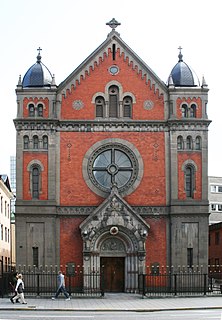
Saint Eric's Cathedral is a Catholic cathedral in Stockholm, Sweden. It is located on Södermalm, the southern part of central Stockholm. It was built in 1892 and was raised to the status of a cathedral in 1953, when the Catholic Diocese of Stockholm was created. The substantial increase in the number of Catholics in Stockholm and Sweden, mostly as a result of immigration after World War II, made the old church insufficient, and an extension, designed by architects Hans Westman and Ylva Lenormand, was inaugurated in 1983, at the 200th anniversary of the re-establishment in 1783 of the Catholic Church in Lutheran Sweden. The block where the cathedral is located also contains other functions serving the Catholic Church in Sweden.
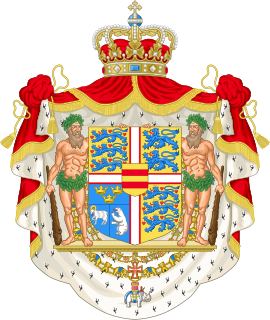
The coat of arms of Denmark has a lesser and a greater version.
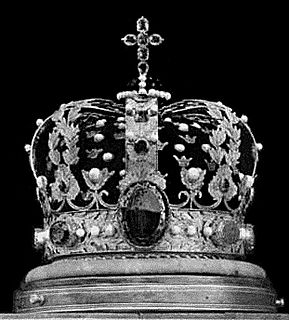
The Crown of Norway is the crown of the King of Norway and was made in Stockholm in 1818 by goldsmith Olof Wihlborg. The crown is a corona clausa consisting of a ring carrying eight hoops made of gold and surmounted by a monde of blue enamel and an amethyst cross on top of it. The crown is decorated with many pearls and gemstones including amethysts, chrysoprases, a topaz and an alexandrite. Its front is adorned with a huge green tourmaline, a gift of the Brazilian consul in Stockholm to King Charles III Johan. Its splendid colours and its richly elaborated ornaments make the crown typical of the Empire period. Although the goldsmith work was carried out by Olof Wihlborg, it is not known who designed the crown.

Holmger Knutsson was a Swedish nobleman and a claimant to the Swedish throne during the reign of King Eric XI of Sweden.
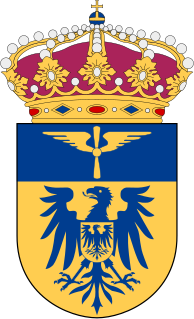
Swedish Air Force Flying School, also F 5 Ljungbyhed, or simply F 5, is a former Swedish Air Force training wing with the main base located in Ljungbyhed in southern Sweden.
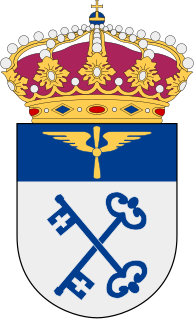
Norrbotten Wing, also F 21 Luleå, or simply F 21, is a Swedish Air Force wing with the main base located in Luleå Airport in northern Sweden. It is one of the three remaining wings in Sweden and currently has two squadrons of multirole aircraft. F 21 in the north and F 17 in the south are the two wings remaining to have operational squadrons. F 7 is a school where pilots begin their training in the JAS 39 Gripen. Once completed the pilot's training is moved out to the two operational wings where they acquire their final training.
![]() Media related to Coats of arms of Stockholm at Wikimedia Commons
Media related to Coats of arms of Stockholm at Wikimedia Commons